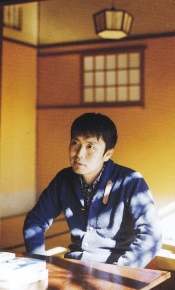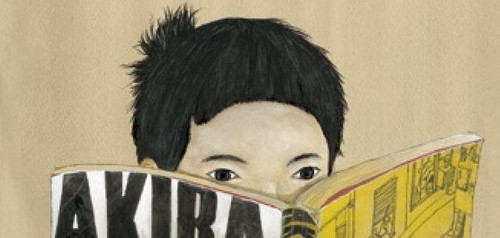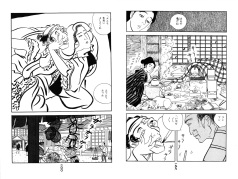Here’s a conversation between Igarashi Daisuke and Taiyou Matsumoto that ran in the magazine Brutus in early 2012.

Picture of Matsumoto and Igarashi, from the relevant issue of Brutus.
1.
Taiyo Matsumoto: I feel like you kind of came out of nowhere. I’ve been drawing manga for about 25 years, but you really blew me away. I first heard your name around the time Witches came out, and at first I thought you were still new to the scene. This guy is just incredible, I thought—it was so polished and everything. I was a little worried for myself.
Daisuke Igarashi: I found out about you when I was a student. Your work was being featured in a magazine or something, and seeing your manga cover designs I thought to myself, “This is really good, this is my kind of art”, but I figured I would probably be influenced by it if I read it, though. That fear kind of trumped everything else, so I avoided your work for a long time. (laugh) Nowadays I actually read your work just to steal from it, though.
Matsumoto: I find I can’t tell who you’ve been influenced by when I look at your work. With most manga artists you can see that, Oh, this artist’s a Katsuhiro Otomo fan, this one’s a Yumi Tada fan. With your art, though, I can’t tell; you leave me wondering, “What artist is this guy into?” You’re original, I guess is what I’m saying. Hmmm… it feels kind of like you’ve come to manga via painting.
Igarashi: I started out wanting to draw less idiosyncratically. I’m seeing the world through my eyes, so inevitably there are all kinds of personal tics of mine that work their way into my drawing, but I think that art should ideally be something that all kinds of different people can look at while seeing as few of those idiosyncrasies as possible. My favorite manga artist would have to be Hinako Sugiura. I also used to read Akira Toriyama and Rumiko Takahashi.
Matsumoto: People mention Sugiura’s knowledge of the Edo period a lot, but she can really put together a manga, too. Her use of words. I really like that one she did about Hokusai. I was hoping to meet her someday.
Igarashi: Ah, you mean Sarusuberi. That’s my favorite of hers, too. In terms of the current direction I’ve gone in, I’d say Hayao Miyazaki was the biggest influence. When I saw Totoro, I sort of realized that, wow, so you can do this kind of thing. There wasn’t much of a connection between the stuff that I like and manga/drawing, so Totoro helped me realize that it’s okay for me to totally focus on drawing manga about things like, say… clear, slightly cold water.
2.
Matsumoto: There was this one time that I was talking with the animator Shoji Morimoto about how great you are, and what he said was that you really understand plants and animals. Like, your leaves are leaves, your cats are cats — that’s what’s amazing. When an artist draws a leaf, Morimoto says he has to understand leaves. I agreed with him, but to actually put that into practice is a different story, which is why lately I’ve been trying not to draw things that I don’t really understand. Your cats are so fluffy, they just feel right. I understand how to do it in theory, but I still can’t actually draw like that.
Igarashi: Your cats are really cat-like, though… and I don’t think I really do much “understanding” when I draw, either.
Matsumoto: The pictures in manga are symbols that are used to develop a story, and our predecessors have come up with a way to draw a cat when a story calls for cats, and a way to draw a worried facial expression when characters are worried, etc., so it’s really easy to fall into the habit of just imitating that and drawing cats without looking at an actual cat. You, though, seem like you actually observe cats, or whatever plant or animal, when you draw them.
Igarashi: I’m really happy to hear you say that.
Matsumoto: For example, in Children of the Sea, when Ruka’s riding her bicycle in the rain, you can practically smell it. It’s that rare kind of manga where you can actually smell the tide, you can smell the concrete.
Igarashi: I’d be more likely to attribute that to the reader being receptive. When I draw, I try to think of it more as if I’m sketching something, so I do my best to keep looking back at my base material, panel by panel, recreating the image in my head. For a reader who doesn’t know what it feels like when you’re standing on the seashore, though—the smell, the feeling of openness, the fear—I don’t think it’s possible for a scene on the seashore to really ring true, which is why I really do feel like I’m leaving the reader with all the responsibility. I do at least try to put together imagery using feelings that somehow ring true for me, though.
3.
 Igarashi: When I started reading Sunny, at first I didn’t know how to go about reading it. I liked your previous work, Takemitsu Zamurai, but when I started reading Sunny in the same way, I had trouble getting into it. Then, around chapter four, I started finding myself getting really into it. Only once I started paying attention to something inside me—this thing that I have in common with the manga—did I really start to “get” Sunny.
Igarashi: When I started reading Sunny, at first I didn’t know how to go about reading it. I liked your previous work, Takemitsu Zamurai, but when I started reading Sunny in the same way, I had trouble getting into it. Then, around chapter four, I started finding myself getting really into it. Only once I started paying attention to something inside me—this thing that I have in common with the manga—did I really start to “get” Sunny.
Matsumoto: Several people have told me it’s hard to get into, actually.
Igarashi: I really liked the story about Shosuke getting lost. I’m the type who likes to read my favorite manga over and over again, and I really find myself coming back to your work all the time.
 Matsumoto: Thank you. Sunny is based on personal experience. I never used to talk much about when I lived separately from my parents, but now I find I can finally stand back and really get a good look at it. I think I needed time to put some distance between that myself and that experience in order to turn it into manga. I started it sort of hesitantly, but after drawing it for a while, I’ve come to feel that the characters are really all me. The children left at the orphanage, the parents who left them there, the people taking care of them at the orphanage — all of them are me.
Matsumoto: Thank you. Sunny is based on personal experience. I never used to talk much about when I lived separately from my parents, but now I find I can finally stand back and really get a good look at it. I think I needed time to put some distance between that myself and that experience in order to turn it into manga. I started it sort of hesitantly, but after drawing it for a while, I’ve come to feel that the characters are really all me. The children left at the orphanage, the parents who left them there, the people taking care of them at the orphanage — all of them are me.
Igarashi: The characters are all so expressive.
Matsumoto: To some degree, I went about starting Sunny by planning out the characters. You’ve got the kid who acts purely out of emotion, you’ve got the logical kid, etc. Having so many different children in the cast, I had to try to keep things balanced. When you’re putting together a piece of fiction, you can’t have a team entirely composed of center forwards, you know?
Igarashi: Reading your manga, you don’t really get the feeling that it was planned out. It feels very organic, which is I think is probably a really good thing. Listening to you now, I can see that obviously you actually do plan out your characters, but it doesn’t feel that way. Maybe it’s because the characters’ emotions are really your emotions.
Matsumoto: When I started drawing it, I started remembering my childhood… perhaps a bit more than I’d have like, even. (laugh) There was a lot of resentment that came out, you see. Like, you start to think about things like, was the person I modelled Adachi the caretaker after actually such a good person? There’ve been times when my memories of reality have gotten jumbled up with my manga. And yet I wasn’t reminded of my past at all back when I was doing Tekkon Kinkreet. When I read Children of the Sea I imagine that Kai and Sora are you, but do you actually think back on personal experience when you draw your manga?
Igarashi: Actual personal experience is a bit too raw, so I have to put distance between it and my manga by doing things like making my characters into girls. Otherwise the manga would get too bogged down in ugly, embarrassing stuff.
Matsumoto: Recently I’ve started to go all out and romanticize in my manga. I’ll take bad memories and turn them into happy stories in my manga, at least up until a point, anyway—I don’t want to insult the reader. (laugh) The characters say things that I wanted to say but couldn’t, and they don’t say the things that I regret saying. Sometimes it feels like I’m rewriting my memories.
Igarashi: You know, I think what you’re drawing is emotions. I don’t really do that. If I try to capture some sort of emotion, something keeps me from drawing it objectively. It’s scary, so I try to stay away from that sort of thing, and maybe that makes my work feel distant. All I really wanted to draw was scenery, so I’m not very good at drawing human expression and I try to avoid it when I can.
Matsumoto: I don’t think you’re bad at drawing emotional expression, but it’s true that you hold it back. But it’s almost like, maybe this is what humans are really like. In manga, people tend to draw with more exaggeration, you know? Like, people will have their characters exclaim “Huh?!” as a symbol of surprise, when in reality, if a person says that, they’re still not really all that surprised. Whereas in Children of the Sea there are all kinds of surprising things happening, yet they don’t show it in their face and just keep it inside. To tell the truth, I was sort of scared to meet you. (laugh) Reading your manga, one gets the impression that you must know everything there is to know about the universe.
Igarashi: Well, I obviously don’t know everything about the universe. (laugh) I want my manga to be compelling, so I try to make it seem like I know what I’m talking about, but I assure you that it’s all put on.
4.
Igarashi: Your manga is really manga-y, I find. When I read someone with more of a gekiga style, the story and the art might be really good, but it doesn’t quite feel like manga. With your manga, though, the art’s really cool, but it still manages to be really manga-y. I guess that’s an abstract way of putting it, but anyway, I’m really jealous of that. I try my best to make my work manga-y too, but…
Matsumoto: Well, for me, when you appeared on the scene I realized that the range of what manga can do was wider than I’d thought. It was like, “Wow, so you can go that far!” You made me wonder what kind of preparation one needed to do to take one’s manga that far. As we were saying earlier about understanding plants and animals, when you draw whales, you can even feel the texture. I used to like drawing whales, but now I feel like I shouldn’t even try anymore. (laugh)
Igarashi: I have the opposite way of looking at it: I force myself to really research things before I feel ready to draw them, so I think it actually restricts my drawing. I like your whales a lot, though—they really look like whales.
Matsumoto: I think I’d like to try to go all out and draw like you do one of these days, but… when you draw a scene under the sea, just reading it feels like I’ve actually gone there, under the sea. You can actually feel the fear as you keep going down deeper. Not just anybody can pull that off.
Igarashi: In the end, manga really is just made up of symbols. When you get down to it, my stuff is symbols too, but I do try my hardest to make it work as pictures, too. I think you’re the same way. Your work is kind of about pictures, if you know what I mean—even in the stories and the words, it feels like a picture. I envy that, the way every panel is a picture unto itself.
Matsumoto: I like your work, but you know who else I like? Fumiko Takano. You look at her work, and there’s this virility to it—like, she can draw a single line and really use it for all its worth, you know?
Igarashi: Yeah, it’s impressive.
Matsumoto: I wish I could do it. The way it feels like she’s taking that bare minimum of pen strokes as far as it can go.
Igarashi: You can feel the texture from the lines, too. Fumiko Takano might be the real perfectionist in the pursuit of manga. If she were to draw an action manga, for example, I feel like she would master martial arts to some degree before sitting down to draw it. It would take way too much time, but I think she would probably do it.
Matsumoto: Yeah, talking with Takano is like being an amateur player talking baseball with Ichiro. Talking with you is the same for me, though. It’s scary, in proportion to how much respect I have for you.
Igarashi: Me? I doubt I’d be able to draw a single line like Takano if my life depended on it. I make so many discoveries when I go back and reread her work, and I’m able to see more in it as I mature. Nausicaa of the Valley of the Wind is the same way — depressingly good.
5.
Igarashi: I think I’ve got some pretty fixed notions about manga, in that for me there’s a right way to do it, and I can’t make up my mind whether I want to diverge from that or not. I feel like really manga-y manga is something for people more talented than me, so I’ve got to go off and do my own thing if I want to stand a chance against those guys. My particular sensibilities don’t really work if I try to do that manga-y sort of manga. I’m not sure yet what the answer is.
Matsumoto: My previous series was Takemitsu Zamurai, where I had this really manga-y fantasy with strong swordsmen doing battle, and I think maybe it’s because I did that that I was able to move on to Sunny, where fact and fiction are mixed together.
Igarashi: Oh, you’re right, Takemitsu Zamurai does have a pretty manga-y format to it. I hadn’t realized that at all. (laugh) For me, I figure if I’m going to draw manga, I ought to take it in a direction toward drawing things that interest me. I think maybe I really want to surprise people, and I get so caught up in that that I don’t pay too much attention to drawing people. I find you manage to strike a really good balance, though. I wish I could do that.
Matsumoto: I think what I do is turn people into characters. In your work, on the other hand, the people exist as people. With the kids in Sunny, I know that, like, this character would say this, and that character would say that, but kids aren’t that clearly defined in real life, are they? My characters aren’t quite Nobita and Giant, but they’re still not real, either. That might be what makes my manga manga-y, and it’s something I aim for. I’d like to be able to have an old man character someday, but if I were to try it now he would only come off as fake. Hopefully one day I’ll be able to make an old man character who comes off as actually human. ♦




they are so nice with each other 🙂
Two of my favorite manga-ka! Love seeing two artists talking about their craft with eachother, and I also like how nice they are, too.